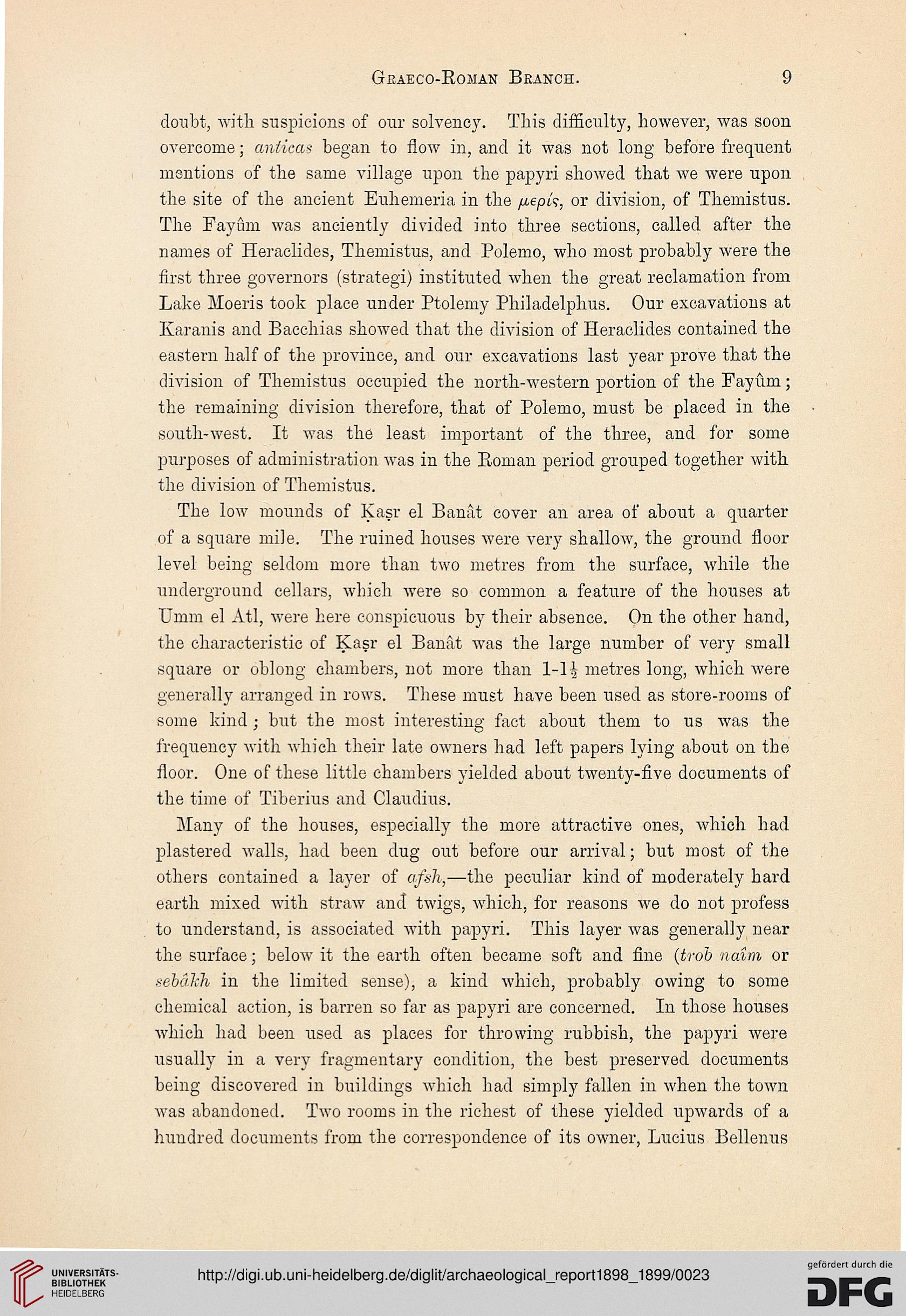Geaeco-Roman Branch.
9
doubt, with suspicions of our solvency. This difficulty, however, was soon
overcome; anficas began to flow in, and it was not long before frequent
mentions of the same village upon the papyri showed that we were upon
the site of the ancient Euhemeria in the fiepk, or division, of Themistus.
The Fayum was anciently divided into three sections, called after the
names of Heraclides, Themistus, and Polemo, who most probably were the
first three governors (strategi) instituted when the great reclamation from
Lake Moeris took place under Ptolemy Philadelphus. Our excavations at
Karanis and Bacchias showed that the division of Heraclides contained the
eastern half of the province, and our excavations last year prove that the
division of Themistus occupied the north-western portion of the Fayum;
the remaining division therefore, that of Polemo, must be placed in the
south-west. It was the least important of the three, and for some
purposes of administration was in the Roman period grouped together with
the division of Themistus.
The low mounds of Kasr el Banat cover an area of about a quarter
of a square mile. The ruined houses were very shallow, the ground floor
level being seldom more than two metres from the surface, while the
underground cellars, which were so common a feature of the houses at
Umm el Atl, were here conspicuous by their absence. On the other hand,
the characteristic of Kasr el Banat was the large number of very small
square or oblong chambers, not more than 1-1 i metres long, which were
generally arranged in rows. These must have been used as store-rooms of
some kind • but the most interesting fact about them to us was the
frequency with which their late owners had left papers lying about on the
floor. One of these little chambers yielded about twenty-five documents of
the time of Tiberius and Claudius.
Many of the houses, especially the more attractive ones, which had
plastered walls, had been dug out before our arrival; but most of the
others contained a layer of afsh,—the peculiar kind of moderately hard
earth mixed with straw and twigs, which, for reasons we do not profess
to understand, is associated with papyri. This layer was generally near
the surface; below it the earth often became soft and fine (trob natm or
sebdJeh in the limited sense), a kind which, probably owing to some
chemical action, is barren so far as papyri are concerned. In those houses
which had been used as places for throwing rubbish, the papyri were
usually in a very fragmentary condition, the best preserved documents
being discovered in buildings which had simply fallen in when the town
was abandoned. Two rooms in the richest of these yielded upwards of a
hundred documents from the correspondence of its owner, Lucius Bellenus
9
doubt, with suspicions of our solvency. This difficulty, however, was soon
overcome; anficas began to flow in, and it was not long before frequent
mentions of the same village upon the papyri showed that we were upon
the site of the ancient Euhemeria in the fiepk, or division, of Themistus.
The Fayum was anciently divided into three sections, called after the
names of Heraclides, Themistus, and Polemo, who most probably were the
first three governors (strategi) instituted when the great reclamation from
Lake Moeris took place under Ptolemy Philadelphus. Our excavations at
Karanis and Bacchias showed that the division of Heraclides contained the
eastern half of the province, and our excavations last year prove that the
division of Themistus occupied the north-western portion of the Fayum;
the remaining division therefore, that of Polemo, must be placed in the
south-west. It was the least important of the three, and for some
purposes of administration was in the Roman period grouped together with
the division of Themistus.
The low mounds of Kasr el Banat cover an area of about a quarter
of a square mile. The ruined houses were very shallow, the ground floor
level being seldom more than two metres from the surface, while the
underground cellars, which were so common a feature of the houses at
Umm el Atl, were here conspicuous by their absence. On the other hand,
the characteristic of Kasr el Banat was the large number of very small
square or oblong chambers, not more than 1-1 i metres long, which were
generally arranged in rows. These must have been used as store-rooms of
some kind • but the most interesting fact about them to us was the
frequency with which their late owners had left papers lying about on the
floor. One of these little chambers yielded about twenty-five documents of
the time of Tiberius and Claudius.
Many of the houses, especially the more attractive ones, which had
plastered walls, had been dug out before our arrival; but most of the
others contained a layer of afsh,—the peculiar kind of moderately hard
earth mixed with straw and twigs, which, for reasons we do not profess
to understand, is associated with papyri. This layer was generally near
the surface; below it the earth often became soft and fine (trob natm or
sebdJeh in the limited sense), a kind which, probably owing to some
chemical action, is barren so far as papyri are concerned. In those houses
which had been used as places for throwing rubbish, the papyri were
usually in a very fragmentary condition, the best preserved documents
being discovered in buildings which had simply fallen in when the town
was abandoned. Two rooms in the richest of these yielded upwards of a
hundred documents from the correspondence of its owner, Lucius Bellenus





